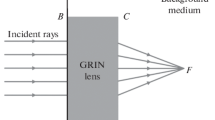Abstract
The paper presents a mathematical tool based on the requirement of tautochronism in each of the diffraction orders of a harmonic kinoform lens, which was used as the basis to develop a method for calculating the lens microstructure. The method provides a limitation of the relative longitudinal chromatism of the lens to a given level. In addition, it allows obtaining the initial parameters necessary for the ray calculation and optimization of an optical system with a harmonic kinoform lens using well-known commercial optical design computer programs.
Similar content being viewed by others
References
D. W. Sweeney, “Harmonic Diffractive Lenses,” Appl. Opt. 34 (14), 2469–2475 (1995).
S. I. Kharitonov, “Geometric-Optical Calculation of the Focal Spot of a Harmonic Diffraction Lens,” Komp. Opt. 40 (3), 331–337 (2016).
S. N. Khonina, “Analysis of the Focusing by a Harmonic Diffraction Lens Taking into Account the Dispersion of the Refractive Index,” Komp. Opt. 41 (3), 338–347 (2017).
G. G. Slusarev, “Optical Systems with Phase Layers,” DAN SSSR 113 (4), 780–782 (1957).
A. I. Antonov, “Diffractive Elements for Imaging Optical Systems,” Autometrya 53 (5), 4–16 (2017) [Optoelecton., Instrum. Data Process. 53 (5), 421–430 (2017)].
G. I. Greysukh, “Harmonic Kinoform Lens: Diffraction Efficiency and Chromatism,” Opt. Spektr. 125 (2), 223–228 (2018).
M. G. Moharam, “Diffraction Analysis of Dielectric Surface-Relief Gratings,” JOSA 72 (10), 1385–1392 (1982).
N. M. Lyndin, “Modal and C Methods Grating Design and Analysis Software,” http://www.mcgrating.co.
M. Kovatchev, “Aberration Characteristics of Optical Elements,” Proc. SPIE. 1183, 643–652 (1989).
J. M. Geary, Introduction to Lens Design: With Practical ZEMAX Examples (Willmann-Bell, Inc., Richmond, 2002).
Author information
Authors and Affiliations
Corresponding author
Additional information
Russian Text © A.I. Antonov, G.I. Greisukh, E.G. Ezhov, E.A. Ryzhova, 2019, published in Avtometriya, 2019, Vol. 55, No. 1, pp. 3–11.
About this article
Cite this article
Antonov, A.I., Greisukh, G.I., Ezhov, E.G. et al. Mathematical Tool for Calculating the Microstructure of a Harmonic Kinoform Lens. Optoelectron.Instrument.Proc. 55, 1–7 (2019). https://doi.org/10.3103/S8756699019010011
Received:
Revised:
Accepted:
Published:
Issue Date:
DOI: https://doi.org/10.3103/S8756699019010011



